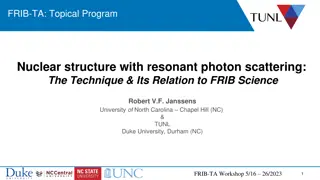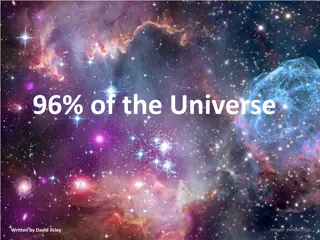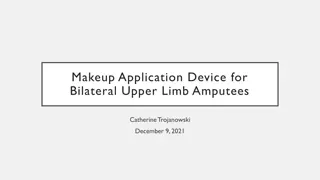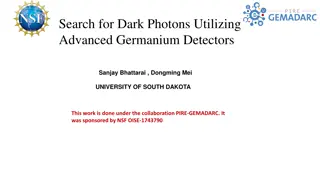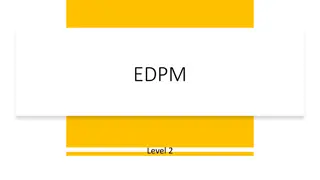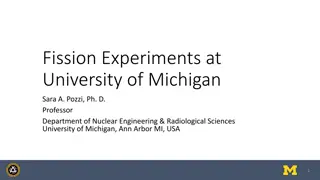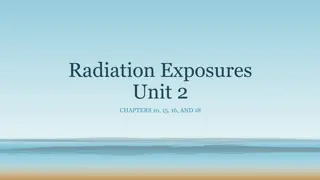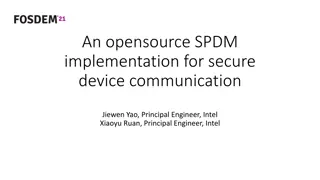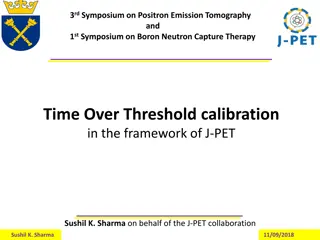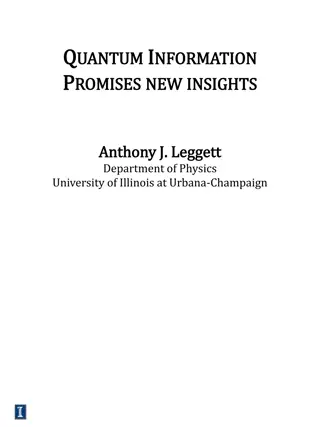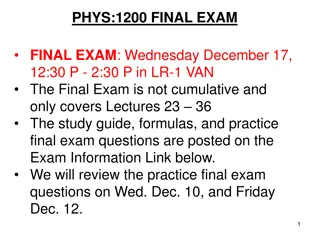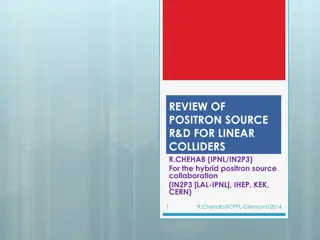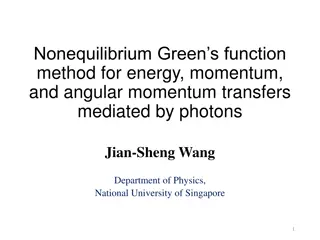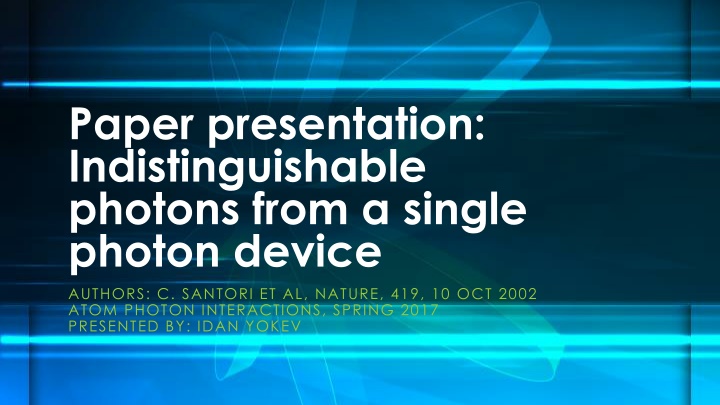
Indistinguishable Photons from Semiconductor Quantum Dots
Explore the groundbreaking experiment by Santori et al. demonstrating the production of indistinguishable photons from semiconductor quantum dots using a Hong-Ou-Mandel experiment. Discover the significance of this achievement in quantum computing and quantum information applications. Dive into the world of quantum dots and microcavities, exploring their potential in advancing quantum technologies.
Download Presentation

Please find below an Image/Link to download the presentation.
The content on the website is provided AS IS for your information and personal use only. It may not be sold, licensed, or shared on other websites without obtaining consent from the author. If you encounter any issues during the download, it is possible that the publisher has removed the file from their server.
You are allowed to download the files provided on this website for personal or commercial use, subject to the condition that they are used lawfully. All files are the property of their respective owners.
The content on the website is provided AS IS for your information and personal use only. It may not be sold, licensed, or shared on other websites without obtaining consent from the author.
E N D
Presentation Transcript
Paper presentation: Indistinguishable photons from a single photon device AUTHORS: C. SANTORI ET AL, NATURE, 419, 10 OCT 2002 ATOM PHOTON INTERACTIONS, SPRING 2017 PRESENTED BY: IDAN YOKEV
Introduction In the paper, Santori et al. demonstrate the production of indistinguishable photons from semiconductor quantum dots using a Hong-Ou-Mandel (HOM) type experiment. Why is this important? What are Quantum Dots? Why the experiment is cool, scientifically speaking
Background THE 3 Q S: QUANTUM COMPUTING, QUANTUM DOTS & QUANTUM BEAM SPLITTERS
Motivation Any Two Level System is a good source Main practical application is quantum information Quantum computing circuits will require sources that can be fabricated and integrated Quantum computing is enabled by the HOM effect
Quantum Dots & microcavities Nano-scale structures with low band gap embedded in a high band gap layer The 3D confinement creates a potential well with discrete energy levels Fabricated Self assembly Microcavity improves coupling efficiency Quantum%20Dots%20Story
Quantum Dots & microcavities Indistinguishability means same state Discrete energy levels control wavelength Microcavity selects mode Q factor and Purcell enhancement Single photon emission require single QD / cavity matching An SEM image of a typical device, showing the tapered etch and contrasting AlAs and GaAs DBR layers Solomon, G. S., M. Pelton, and Y. Yamamoto. "Single-mode spontaneous emission from a single quantum dot in a three-dimensional microcavity." Physical Review Letters 86.17 (2001): 3903.
Theory for Hong-Ou-Mandel BS with photons occupying both input ports Sum of amplitudes Phase shift between options 2 & 3 Destructive interference |????= 2 |23,04+ |03,24 Quantum Electronics Course, TAU CC BY-SA 3.0, https://en.wikipedia.org/w/index.php?curid=18378806
Theory for Hong-Ou-Mandel In classical and coherent interference, we know: ?2? = 0 ?2? = 2 2 can only be explained by ?2<1 quantum interference
Experiment Details and Results IN 3 ACTS
Experimental setup ? 13 ns HBT to test single photon emission 13 ns . . . HOM to test Degree Of Indistinguishability (DOI) Correlation is defined as delay between detectors: ? = ?2 ?1 ?2 as a figure of merit, histogram of ? Histogram is symmetric Very low combined efficiency: ?2~2.3 10 6
Act I Single photon source, HBT ? 13 ns 13 ns . . . 13 ns The probability for more than 1 photon emission is calculated by dividing the area of the central (non) peak by the area of adjacent side peaks ? is the normalized probability the either of 2 consecutive pulses 2?? to generate 2 photons
Act 2 two photon interference, HOM Pulse 1 fires at ? = 0 Pulse 1 Pulse 2 Detector 1 Detector 2 ? ?? Pulse 2 fires at ? = 2?? Long arm Short arm Start Stop 0 The long arm is 2?? longer than the short arm Long arm Short arm Stop Start 0 Short arm Short arm Start Stop 2 Assuming equal probabilities we expect 5 peaks with ratio of: 1:2:2:2:1 Short arm Short arm Stop Start -2 Long arm Long arm Start Stop 2 Long arm Long arm Stop Start -2 Short arm Long arm Start Stop 4 Short arm Long arm Stop Start -4 Gantz, L. "Quantum bits utilizing the quantum dot confined bright and dark excitons" Research Thesis, Technion
Act 2 two photon interference, HOM ? at peaks numbered 1-5 is: -4,-2,0,2,4 ns respectively
Act 3 qualifying the source Relative mean areas of the peaks can be calculated: ?1= ?3? , ?2= [?3? 1 + 2? + ??3] ?3= ?3? + ??3 1 + 2? 2 1 ?2?2?2? ?? ?4= ?3? + ??31 + 2? , ?,? are the BS coefficients ,? was defined above, 1 ? is the visibility of the interferometer itself ?5= ??3 ? ? is the mean overlap between wave packets This is the DOI
Act 3 qualifying the source A dephasing measure is defined ? ? = ?3?2+ ?4 The experiment was repeated at varying ? Finding a fit for ? allows estimating ? 0 After considering setup imperfections overlap was estimated at ? 0 = 0.81 for the best QD
Conclusions & further studies The authors demonstrated the first case of a semiconductor based single photon source with high DOI The authors also demonstrate an elegant setup to compare quality of single photon sources The dephasing factor was fitted empirically and doesn t provide any physical insight Future works have developed a more comprehensive model to explain dephasing as effects within the quantum source Entire work was done in close to absolute zero Efficiency must be greatly increased
Motivation - LOQC LOQC can use photon polarization as the two level system that defines a qubit LOQC has 2 basic components to create a quantum gate Phase shifters apply a linear single qubit operation Beam splitters for 2 qubits operation Nonlinear phase shifts on one mode Under these condition, for the beam splitter to utilize the quantum aspects of the photons, the photons must be indistinguishable Duan, Lu-Ming, et al. "Long-distance quantum communication with atomic ensembles and linear optics." arXiv preprint quant-ph/0105105 (2001). Conditional flip sign c-z: |? 1?? |? |? |?
Quantum Mach-Zehnder Interferometer For classical fields, assuming ?2= 0 the output will be proportional to the phase difference between the paths Ideally oscillating between full constructive interference and full destructive interference in each port In the quantum picture as well the probability to find a photon at each port is related to path difference The joint transfer matrix for the quantum analysis is the same as in the classical case In both pictures the visibility is lost as the absolute path length exceeds coherence time
Single photon source measurements QDs have 2 more properties that significantly effect the DOI Spontaneous emission lifetime ?? Coherence length ?? ?? is measured for each QD by camera ?? is measured using a Michelson Interferometer Same properties as Mach-Zehnder At each fraction of ns scale ? the path is fine tuned at ? scale to scan visibility An ideal source would have: 2????= 1

